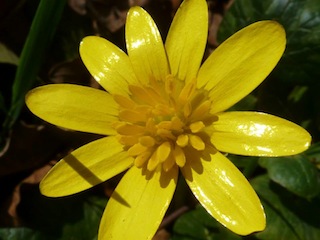 The bright buttery glint of Lesser Celandine in the hedgerows and fields is a welcome early sign of spring.
The bright buttery glint of Lesser Celandine in the hedgerows and fields is a welcome early sign of spring.
Photo: Steve Townsend
Scientific name: Ficaria verna (previously Ranunculus ficaria)
Other common names: Pilewort, Smallwort, Brighteye, Cheesecups, Butter and Cheese
There’s a flower that shall be mine,
‘Tis the little Celandine.
 The lovely, butter-coloured Lesser Celandine may be common, but it is a favourite in literature. C.S. Lewis, Edward Thomas and D.H. Lawrence all mention Lesser Celandine, and Wordsworth wrote three poems in its praise, including To the Small Celandine, from which the lines above are taken. It was the poet’s favourite wildflower.
The lovely, butter-coloured Lesser Celandine may be common, but it is a favourite in literature. C.S. Lewis, Edward Thomas and D.H. Lawrence all mention Lesser Celandine, and Wordsworth wrote three poems in its praise, including To the Small Celandine, from which the lines above are taken. It was the poet’s favourite wildflower.
Lesser Celandine used to be known in some parts of the country as ‘Spring Messenger’, a reference to its flowers being one of the first signs of approaching spring. It blooms as early as mid to late February, its butter-yellow flowers held above the dark green, heart-shaped leaves low to the ground. Bees and other insects love it as an early source of nectar.
It’s a good weather barometer as well: if you see the flowers closing during daylight hours, this means it is about to rain. The flowers always close overnight, and keep ‘office hours’ during the day, opening when the sun has fully risen and closing again in the early evening.
Widely distributed across Britain, Lesser Celandine, a member of the Buttercup family (Ranunculaceae), is a plant of woodland, meadows and hedges, with a particular liking for damper places. It grows and spreads from underground tubers: the fig-like appearance of these gives the plant its scientific name of Ficaria, the Latin word for ‘fig’. Less charming is the notion that the tubers resemble a bunch of haemorrhoids; the plant was in fact once used to treat piles. Once the plant dies back in early summer, the tubers continue to store nutrients, ready to brighten the following spring.

What’s in a name? There is another plant called Greater Celandine (Chelidonium majus), and you’d be forgiven for assuming it was closely related to Lesser Celandine. However, Greater Celandine is in fact a member of the Poppy family. It also has yellow flowers, and it is possibly this superficial resemblance that led to the confusion. The name celandine is derived from the Latin for swallow. It is probably more likely that the name was first given to Greater Celandine, which blossoms in May as the swallows arrive back to our shores: even the hardiest swallow is unlikely to arrive as Lesser Celandine blossoms, braving our February temperatures!
Did you know…?
… Lesser Celandines were supposed to be carved on William Wordsworth’s memorial plaque at Grasmere. However, someone got confused and the carving is of Greater Celandine!
…Lesser Celandine leaves were used to treat scurvy in the Middle Ages: they are a rich source of Vitamin C.
More information and references:
Mabey, R., 1997. Flora Britannica. Chatto & Windus, London.
Rose, F. and O’Reilly, C., 2006. The Wild Flower Key, 2nd edition. Frederick Warne, London.
Stace, C., 2010. New Flora of the British Isles, 3rd edition. Cambridge University Press, Cambridge.
Published: March 2014
Author: Amanda Scott
Photos: Steve Townsend
